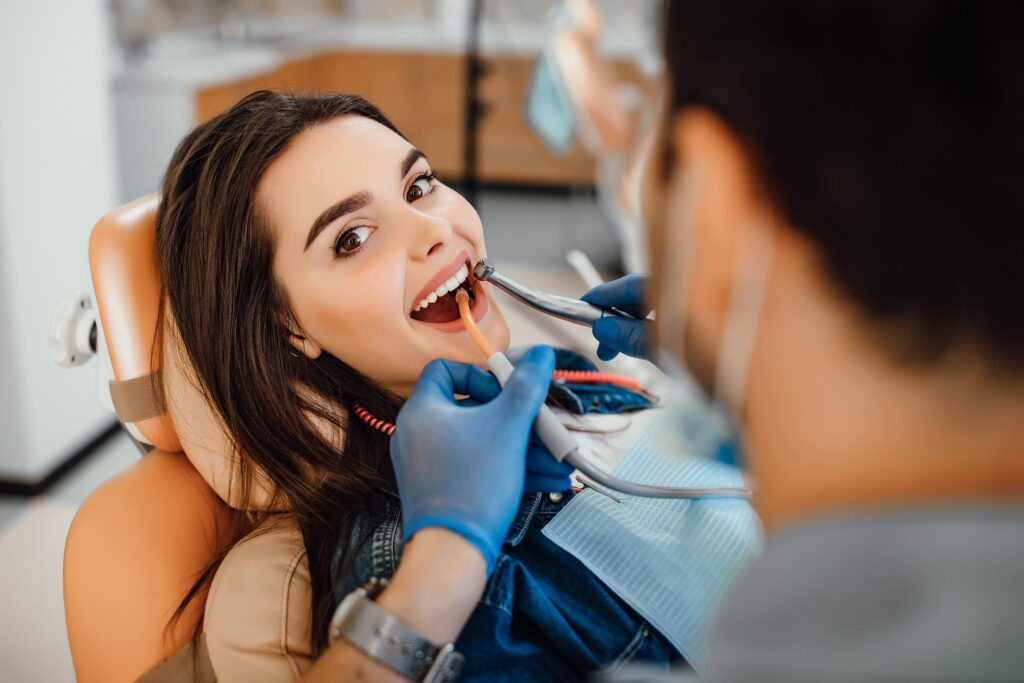General Dentistry in Govandi

General dentistry encompasses the wide range of dental services provided by dentists to promote oral health and treat common dental issues. General Dentistry in Govandi offers preventive care, routine check-ups, and treatments for patients of all ages, serving as the foundation for long-term oral health. They perform dental examinations, cleanings, and X-rays to identify and prevent oral problems such as cavities, gum disease, and oral infections.
General dentistry also includes procedures like fillings, root canals, tooth extractions, and dental prosthetics like crowns and dentures. Dentists educate patients on proper oral hygiene practices, provide guidance on diet and lifestyle factors affecting oral health, and refer patients to specialists for complex treatments when necessary. General dentistry ensures comprehensive dental care for maintaining a healthy and functional smile.
Patients seeking comprehensive dental care can find trusted solutions through General Dentistry in Govandi, covering both preventive and restorative treatments.
Treatments Under General Dentistry

Cosmetic Filling
Cosmetic fillings, one of the services offered under General Dentistry in Govandi, are a popular dental option for restoring teeth affected by decay or minor damage. These fillings are made of a composite resin material that closely matches the natural color of the tooth, resulting in a seamless and natural-looking restoration. The process involves removing the decayed and weak portion of the tooth, and then applying and shaping the composite resin material.
Cosmetic fillings offer several benefits, including their ability to blend with the natural teeth, providing an aesthetically pleasing result. Additionally, they bond well to the tooth structure, require minimal removal of healthy tooth material, and are less sensitive compared to other filling materials. Cosmetic fillings provide a reliable and attractive solution to enhance the appearance and functionality of the teeth while maintaining a natural smile.
Teeth Extraction
Tooth extraction is a dental procedure where a tooth is carefully removed from its socket in the jawbone.As part of General Dentistry in Govandi, extractions are carried out with care to ensure comfort and proper healing. This may be necessary if a tooth is severely damaged or decayed, causing pain or infection. The process begins with the dentist administering a local anesthetic to numb the area around the tooth, ensuring a comfortable procedure. Using specialized tools, the dentist gently loosens the tooth and removes it from the socket. A blood clot then forms in the empty socket, and the dentist provides instructions for proper healing, such as avoiding certain foods and maintaining oral hygiene.
Tooth extraction may be followed by options like dental implants, bridges, or dentures to restore missing teeth. Dentists prioritize patient comfort and take measures to ensure a smooth and painfree extraction process.


Root Canal Treatments
Root canal treatment, also known as endodontic treatment, is a dental procedure performed to save a severely damaged or infected natural tooth. It involves removing the infected pulp, which is the soft tissue inside the tooth, and cleaning its extensions into the roots. A local anesthetic is given to numb the area and ensure a pain-free experience. Then, a small access hole is created in the tooth to remove the infected pulp and clean the canals using specialized tools.
The canals are then filled with a rubber-like material called gutta-percha and medicinal sealers to seal them and prevent further infection. After the root canal procedure, a dental crown is often placed over the treated tooth to provide strength and protection. This allows the tooth to function normally and blends in with the surrounding teeth
Root canal treatment is an effective way to save a tooth from extraction and eliminate pain caused by infection. It allows individuals in Govandi to maintain their natural smile and bite, thanks to expert care available through General Dentistry in Govandi.
Frequently Asked Questions
General Dentistry in Govandi involves the diagnosis, treatment, and prevention of common dental issues, focusing on maintaining overall oral health for all age groups.
General dentistry services include dental exams, cleanings, fillings, root canal therapy, tooth extractions, gum disease treatment, and oral cancer screenings.
Regular dental check-ups are important because they allow the dentist to detect and address dental problems early on, preventing them from worsening and requiring more extensive treatments.
It is generally recommended to visit the dentist every six months for regular check-ups and cleanings. However, the frequency may vary based on your oral health needs, so consult with your dentist for personalized recommendations.
Dental cleaning, or prophylaxis, is a procedure that involves the removal of plaque, tartar, and stains from the teeth. It is necessary to prevent tooth decay, gum disease, and maintain good oral hygiene.
Dental fillings are materials used to restore teeth damaged by decay. They are needed when a cavity is present to prevent further decay and restore the tooth’s function and appearance.
Root canal therapy is a treatment used to save a severely decayed or infected tooth. It involves removing the infected pulp, cleaning and disinfecting the tooth, and filling it with a dental material.
Tooth extraction is necessary when a tooth is severely decayed, infected, impacted, or overcrowded. It may also be done in preparation for orthodontic treatment.
Gum disease, or periodontal disease, is an infection of the gums and tissues surrounding the teeth. It can be treated through non-surgical methods like scaling and root planing, or in more advanced cases, through surgical intervention.
Oral cancer screenings are important because they can detect the early signs of oral cancer, improving the chances of successful treatment. Regular screenings are particularly crucial for individuals at higher risk.
To maintain good oral hygiene at home, you should brush your teeth at least twice a day, floss daily, use mouthwash, eat a balanced diet, and avoid tobacco products.
Yes, dental X-rays are generally safe. The amount of radiation exposure from dental X-rays is minimal, and protective measures like lead aprons and collars are used to further minimize exposure.
